Derivation of Predictive Layers Using Regional Till Geochemistry Data for Mineral Potential Mapping of the REE Line of Bergslagen, Central Sweden
Abstract
1. Introduction
2. Geological Background
3. Quaternary Geology
Quaternary Geology of Bergslagen
4. The Mineral Systems Approach to Mineral Potential Mapping and Its Application to Bergslagen
- Lithostratigraphic factors: REE skarn deposits in Bergslagen form within supracrustal inliers of felsic volcanic rocks of calc–alkaline affinity and in proximity to banded iron formation. Skarn or limestone contacts with the supracrustal rock, indicating favorable conditions for REE mineralization.
- Geochemical factors: spatial associations of elements related to skarn-type mineralizations, i.e., Fe, Mg, REE+Y, and P.
- Geophysical factors: REE mineralization demonstrates positive associations with areas of high magnetic intensity based on aeromagnetic surveys. Highly magnetic rocks stretch along the length of the REE line, representing the magnetite-bearing mineralizations.
- Alteration: Rocks in Bergslagen are variably altered, with regional-scale alteration stronger in the vicinity of mineralizations. Alteration is typically ±K, ±Mg, or ±Na, and occasionally lesser Fe alteration. Thus, tools such as the alteration index [27] or the chlorite–pyrite–plagioclase index (CCPI) [28], which examine variations in the ratios of K, Mg, Na, and Fe originating from mineral alteration, can be used to identify the degree of alteration.
- A key factor in the formation of mineralizations in Bergslagen is the circulation of hydrothermal fluids, which requires a heat source. Heat generated by intrusive or synvolcanic rocks, with ages from 1.97 to 1.87 Ga and 1.8 Ga, is proposed to have acted as a driver for hydrothermal circulation.
- Structural factors: Spatial distribution of REE mineralization in Bergslagen shows a relationship to the D2 deformation phase, or at least processes coeval with D2 [29]. The pattern of magnetic anomalies in the REE line is s-folded, with known REE deposits occurring within these s-folds, more specifically where the fold pattern turns to a more northerly direction.
5. Materials and Methods
5.1. Till Sampling Methodology
5.2. Geochemical Analysis of Till
5.3. Data Treatment Methodology
5.3.1. Transformation of Sampling Coordinates
5.3.2. Exploratory Data Analysis
5.4. Principal Component Analysis
5.5. K-Means Clustering
5.6. Alteration Index
6. Results
6.1. All-Element Data
6.1.1. PCA Analysis of All-Element Data
6.1.2. Clustering Results of All-Element Data
6.2. Trace-Element Data
6.2.1. PCA Results Trace-Element Data
6.2.2. Trace-Element Clustering
6.3. Alteration Index
7. Discussion
7.1. All-Element Data
7.2. Trace-Element Data
7.3. Generation of Predictive Layers for Prospectivity Mapping
8. Conclusions
Author Contributions
Funding
Data Availability Statement
Acknowledgments
Conflicts of Interest
References
- Grohol, M.; Veeh, C. Study on the Critical Raw Materials for the EU 2023—Final Report. Publications Office of the European Union. 2023. Available online: https://data.europa.eu/doi/10.2873/725585 (accessed on 22 February 2024).
- Taylor, S.R.; McLennan, S.M. The Continental Crust: Its Composition and Evolution; Blackwell: Oxford, UK, 1985. [Google Scholar] [CrossRef]
- Nordenskiöld, I. Der pegmatit von Ytterby. Bull. Geol. Inst. Univ. Upps. 1908, 9, 183–228. [Google Scholar]
- Hisinger, W.; Berzelius, J. Cerium, en ny Metall, Funnen i Bastnäs Tungsten, från Riddarhyttan i Westmanland; Henrik A. Nordström förlag: Stockholm, Sweden, 1804. [Google Scholar]
- Sahlström, F.; Jonsson, E.; Högdahl, K.; Troll, V.R.; Harris, C.; Jolis, E.M.; Weis, F. Interaction between high-temperature magmatic fluids and limestone explains ‘Bastnäs-type’ REE deposits in central Sweden. Sci. Rep. 2019, 1, 15203. [Google Scholar] [CrossRef] [PubMed]
- Yousefi, M.; Carranza, E.J.M.; Kreuzer, O.P.; Nykänen, V.; Hronsky, M.A.; Mihalasky, M.J. Data analysis methods for prospectivity modeling as applied to mineral exploration targeting: State-of-the-art and outlook. J. Geochem. Explor. 2021, 229, 106839. [Google Scholar] [CrossRef]
- McCuaig, T.C.; Beresford, S.; Hronsky, J. Translating the mineral systems approach into an effective exploration targeting system. Ore Geol. Rev. 2010, 3, 128–138. [Google Scholar] [CrossRef]
- Sadeghi, M.; Andersson, S.S.; Jonsson, E. A Preliminary Approach to Target Generation for Bastnäs-Type REE Mineralisation in Bergslagen, Sweden; Open File Research Report 29/2023; Geological survey of Finland (GTK): Espoo, Finland, 2023. [Google Scholar]
- Canil, D.; Lacourse, T. An estimate for the bulk composition of juvenile upper continental crust derived from glacial till in the North American Cordillera. Chem. Geol. 2011, 3, 229–239. [Google Scholar] [CrossRef]
- Roberts, S.; Palmer, M.R.; Waller, L. Sm-Nd and REE characteristics of tourmaline and scheelite from the Bjorkdal gold deposit, northern Sweden: Evidence of an intrusion-related gold deposit? Eco. Geo. 2006, 7, 1415–1425. [Google Scholar] [CrossRef]
- McClenaghan, B.M.; Paulen, R.C.; Smith, R.C.; Rice, J.M.; Plouffe, A.; McMartin, I.; Campbell, J.E.; Parsasadr, M.; Lethonen, M. Review of till geochemistry, indicator mineral, and boulder tracing methods for mineral exploration in glaciated terrain. Geochem. Explor. Environ. Anal. 2023, 23, geochem2023-013. [Google Scholar] [CrossRef]
- Normandeau, P.X.; McMartin, I.; Corriveau, L. Till Geochemistry as a Vector to Metasomatic Iron and Alkali-Calcic Systems and Associated Deposits in the Great Bear Magmatic Zone, Northwest Territories, Canada. Minerals 2024, 6, 547. [Google Scholar] [CrossRef]
- Lax, K.; Selinus, O. Geochemical mapping at the Geological Survey of Sweden. Geochem. Explor. Environ. Anal. 2005, 5, 337–346. [Google Scholar] [CrossRef]
- Sadeghi, M.; Casey, P.; Carranza, J.; Lynch, E. Principal Components Analysis and K-Means Clustering of Till Geochemical Data: Mapping and Targeting of Prospective Areas for Lithium Exploration in Västernorrland Region, Sweden. Ore Geol. Rev. 2024, 167, 106002. [Google Scholar] [CrossRef]
- Allen, R.L.; Lundstrom, I.; Ripa, M.; Christofferson, H. Facies analysis of a 1.9 Ga, continental margin, back-arc, felsic caldera province with diverse Zn-Pb-Ag-(Cu-Au) sulfide and Fe oxide deposits, Bergslagen region, Sweden. Econ. Geol. 1996, 6, 979–1008. [Google Scholar] [CrossRef]
- Stephens, M.B.; Weihed, J.B. (Eds.) . Sweden: Lithotectonic Framework, Tectonic Evolution and Mineral Resources; Geological Society of London: London, UK, 2020. [Google Scholar]
- Jonsson, E.; Högdahl, K. New evidence for the timing of formation of Bastnäs-type REE mineralisation in Bergslagen, Sweden. In Proceedings of the Mineral Deposit Research for a High-Tech World–Proceedings of the 12th Biennial SGA Meeting, Uppsala, Sweden, 12–15 August 2013; pp. 1724–1727. [Google Scholar]
- Geijer, P. The geological significance of the cerium mineral occurrences of the Bastnäs type in central Sweden. Arkiv Min. Geol. 1961, 3, 99–105. [Google Scholar]
- Holtstam, D.; Andersson, U.B. The REE minerals of the Bastnas-type deposits, south-central Sweden. Can. Min. 2007, 5, 1073–1114. [Google Scholar] [CrossRef]
- Holtstam, D.; Andersson, U.B.; Broman, C.; Mansfeld, J. Origin of REE mineralization in the Bastnäs-type Fe-REE-(Cu-Mo-Bi-Au) deposits, Bergslagen, Sweden. Min. Dep. 2014, 49, 933–966. [Google Scholar] [CrossRef]
- Holtstam, D.; Casey, P.; Bindi, L.; Förster, H.J.; Karlsson, A.; Appelt, O. Fluorbritholite-(Nd), Ca2Nd3(SiO4)3F, a new and key mineral for neodymium sequestration in REE skarns. Min. Mag. 2023, 5, 731–737. [Google Scholar] [CrossRef]
- Robertsson, A.-M.; Lundqvist, J.; Brunnberg, L. Dark clayey till in central and northern Sweden—Microfossil content and stratigraphical importance. GFF 2005, 127, 169–178. [Google Scholar] [CrossRef]
- Björck, J.; Andrén, T.; Wastegård, S.; Possnert, G.; Schoning, K. An event stratigraphy for the Last Glacial-Holocene transition in eastern middle Sweden: Results from investigations of varved clay and terrestrial sequences. Quat. Sci. Rev. 2002, 1, 489–501. [Google Scholar] [CrossRef]
- Andersson, M.; Ripa, M.; Smith, C. Geokemisk kartering i Västra Bergslagen; Rapport 2020:01; Sveriges Geologiska Undersökning: Uppsala, Sweden, 2020; p. 38. [Google Scholar]
- Carranza, E.J.M. Geochemical mineral exploration: Should we use enrichment factors or log-ratios? Nat. Resour. Res. 2017, 26, 411–428. [Google Scholar] [CrossRef]
- Sadeghi, M.; Ripa, M. Conceptual models for rare earth element exploration in Sweden. In Rare Earth Elements Distribution, Mineralisation and Exploration Potential in Sweden; Sadeghi, M., Ed.; Sveriges Geologiska Undersökning Rapporter Och Meddelanden; Sveriges Geologiska Undersökning: Uppsala, Sweden, 2019; Volume 146, pp. 135–147. [Google Scholar]
- Ishikawa, Y.; Sawaguchi, T.; Iwaya, S.; Horiuchi, M. Delineation of prospecting targets for Kuroko deposits based on modes of volcanism of underlying dacite and alteration haloes. Min. Geol. 1976, 26, 105–117. [Google Scholar]
- Franklin, J.M.; Lydon, J.W.; Sangster, D.F. Volcanic-associated massive sulfide deposits. Eco. Geol. 1981, 75th Anniversary Volume. 485–627. [Google Scholar]
- Stephens, M.B.; Ripa, M.; Lundström, I.; Persson, L.; Bergman, T.; Ahl, M.; Wahlgren, C.-H.; Persson, P.-O.; Wickström, L. Synthesis of the Bedrock Geology in the Bergslagen Region, Fennoscandian Shield, South-Central Sweden; Sveriges Geologiska Undersökning: Uppsala, Sweden, 2009; Ba 58; p. 258. [Google Scholar]
- MacLean, W.H. Rare earth element mobility at constant inter-REE ratios in the alteration zone at the Phelps Dodge massive sulphide deposit, Matagami, Quebec. Min. Dep. 1988, 23, 231–238. [Google Scholar] [CrossRef]
- SS 28311; Soil Analysis—Determination of Trace Elements in Soils—Extraction with Nitric Acid. Swedish Standard: Stockholm, Sweden, 2007.
- Miguel, A.L.R.; Moreiraa, R.P.L.; Oliveira, A.F.D. ISO/IEC 17025: History and introduction of concepts. Química Nova 2021, 6, 792–796. [Google Scholar] [CrossRef]
- Morris, G.A.; Ladenberger, A. Till Geochemistry by Nitric Acid (HNO3) partial leaching at the Geological Survey of Sweden. Geol. Surv. Swed. 2017, 14, 135–147. [Google Scholar]
- Sadeghi, M.; Arvanitidis, N.; Ladenberger, A. Geochemistry of Rare Earth Elements in Bedrock and Till, Applied in the Context of Mineral Potential in Sweden. Minerals 2020, 10, 365. [Google Scholar] [CrossRef]
- Reimann, C.; Filzmoser, P.; Garrett, R.; Dutter, R. Statistical Data Analysis Explained: Applied Environmental Statistics with R; John Wiley Sons: Chichester, UK, 2008; ISBN 9780470987605. [Google Scholar]
- Kaiser, H.F. On Cliff’s formula, the Kaiser-Guttman rule, and the number of factors. Percept. Mot. Ski. 1992, 74, 595–598. [Google Scholar] [CrossRef]
- Aitchison, J. The statistical analysis of geochemical compositions. J. Intl. Assoc. Math. Geol. 1984, 16, 531–564. [Google Scholar] [CrossRef]
- Aitchison, J. The statistical analysis of compositional data. In Monographs on Statistics and Applied Probability; Chapman Hall Ltd.: London, UK, 1986; p. 486. [Google Scholar]
- Egozcue, J.J.; Pawlowsky-Glahn, V.; Mateu-Figueras, G.; Barcelo-Vidal, C. Isometric logratio transformation for compositional data analysis. Math. Geol. 2003, 35, 279–300. [Google Scholar] [CrossRef]
- Peres-Neto, P.R.; Jackson, D.A.; Somers, K.M. Giving meaningful interpretation to ordination axes: Assessing loading significance in principal component analysis. Ecology 2003, 9, 2347–2363. [Google Scholar] [CrossRef]
- Madhulatha, T.S. An overview on clustering methods. IOSR J. Eng. 2012, 4, 719–725. [Google Scholar] [CrossRef]
- Parsa, M.; Sadeghi, M.; Grunsky, E. Innovative methods applied to processing and interpreting geochemical data. J. Geochem. Explor. 2022, 237, 106983. [Google Scholar] [CrossRef]
- MacQueen, J. Some methods for classification and analysis of multivariate observations. In Proceedings of the Fifth Berkeley Symposium on Mathematical Statistics and Probability, Berkeley, CA, USA, 21 June–18 July 1965; pp. 281–297. [Google Scholar]
- Sadeghi, M. Regional metamorphism versus hydrothermal alteration/ metasomatism related to sulphide mineralisation in the Bergslagen district, Sweden. Mineral deposit research for a high-tech world. In Proceedings of the 12th Biennial SGA Meeting, Uppsala, Sweden, 12–15 August 2013; Volume 1, pp. 434–436. [Google Scholar]
- Large, R.R.; Gemmell, J.B.; Paulick, H.; Huston, D.L. The alteration box plot: A simple approach to understanding the relationship between alteration mineralogy and lithogeochemistry associated with volcanic-hosted massive sulfide deposits. Eco. Geol. 2001, 96, 957–971. [Google Scholar] [CrossRef]
- Lynch, E.; Berggren, R.; Bergman, S. Geochemical and Geophysical Assessment of c. 1.8 Ga Granites Associated with W-F ± Mo Mineralisation, Western Bergslagen; SGU Rapport 2023:13; Sveriges Geologiska Undersökning: Uppsala, Sweden, 2013; 75p. [Google Scholar]
- Månbro, C. The Geology and Geochemistry of the Håkansboda Cu-Co Deposit, Bergslagen, Sweden. Master’s Thesis, Stockholms University, Stockholm, Sweden, 2021; p. 90. [Google Scholar]
- Torppa, J.; Middleton, M.; Hyvönen, E.; Lerssi, J.; Fraser, S. A novel spatial analysis approach for assessing regional-scale mineral prospectivity in northern Finland. Geol. Surv. Finl. 2015, 57, 87–120. [Google Scholar]
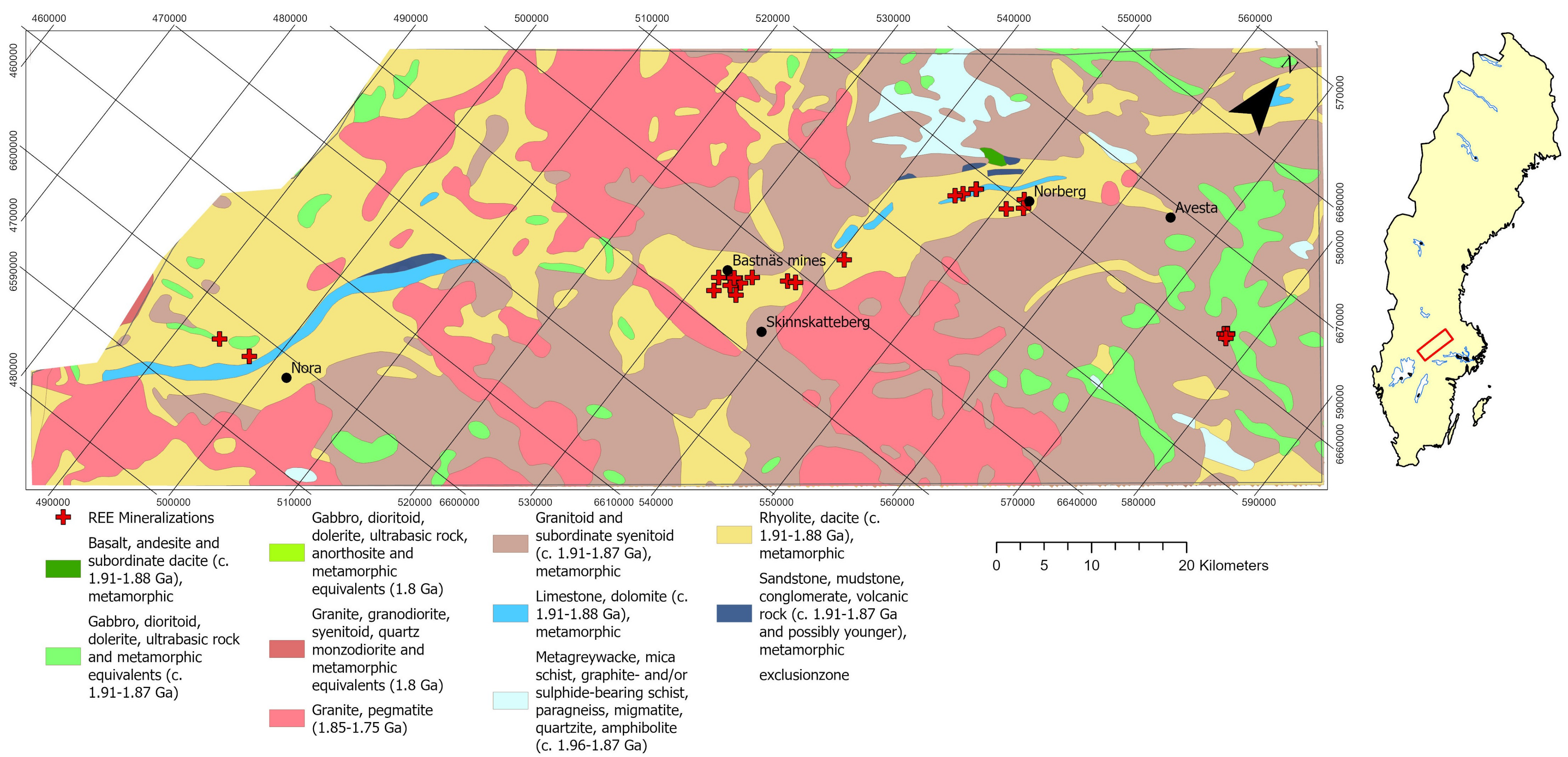


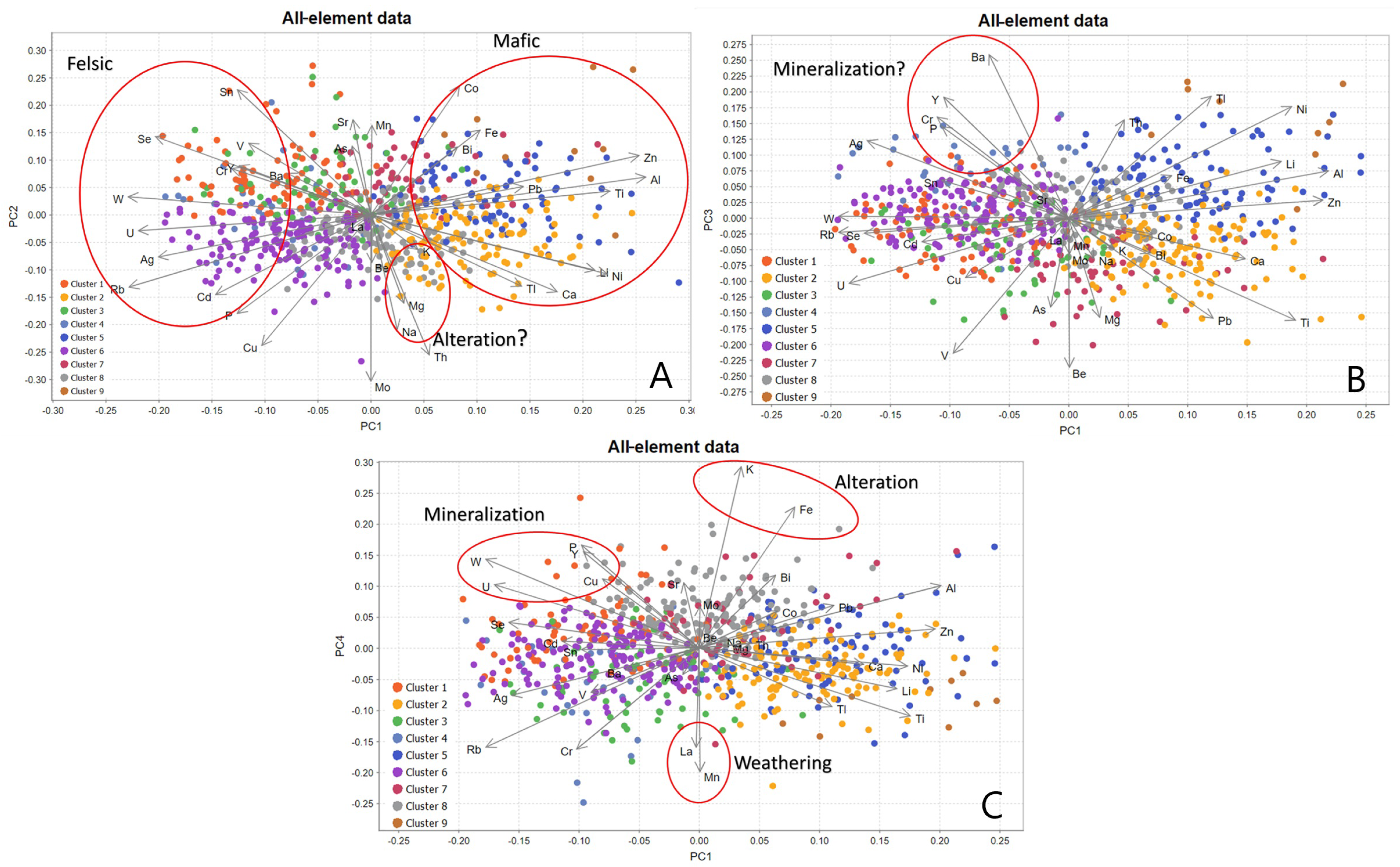
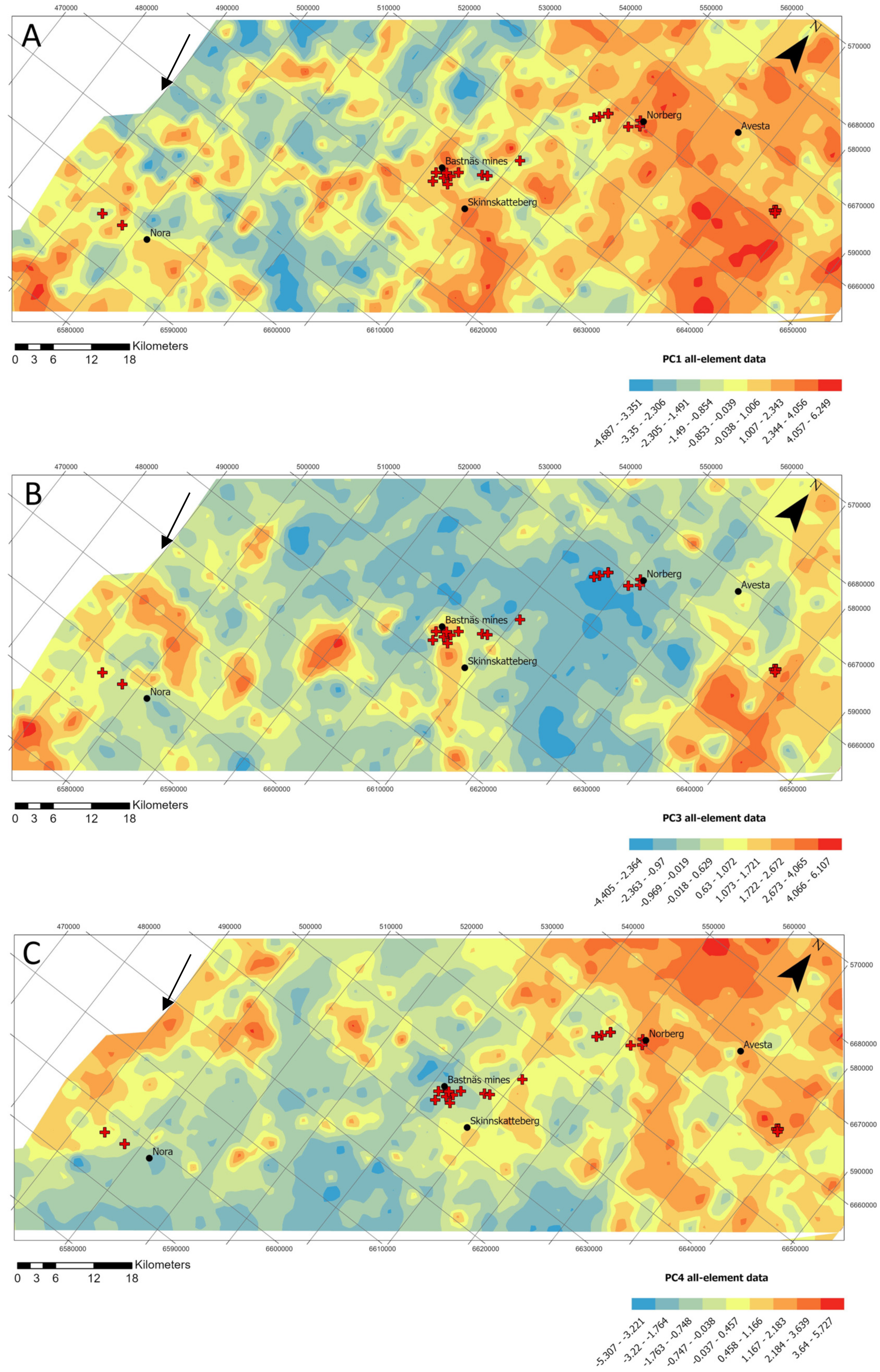
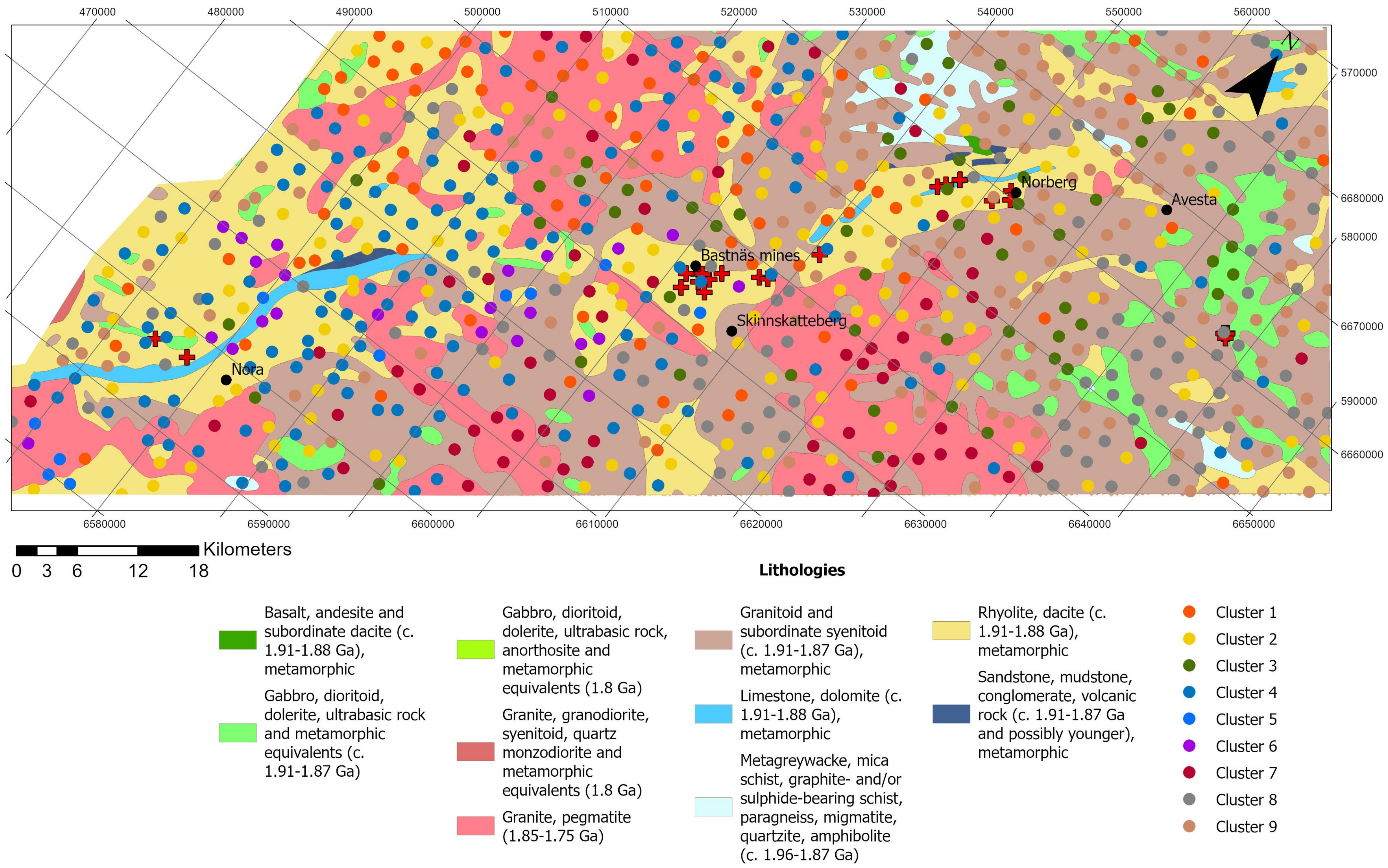

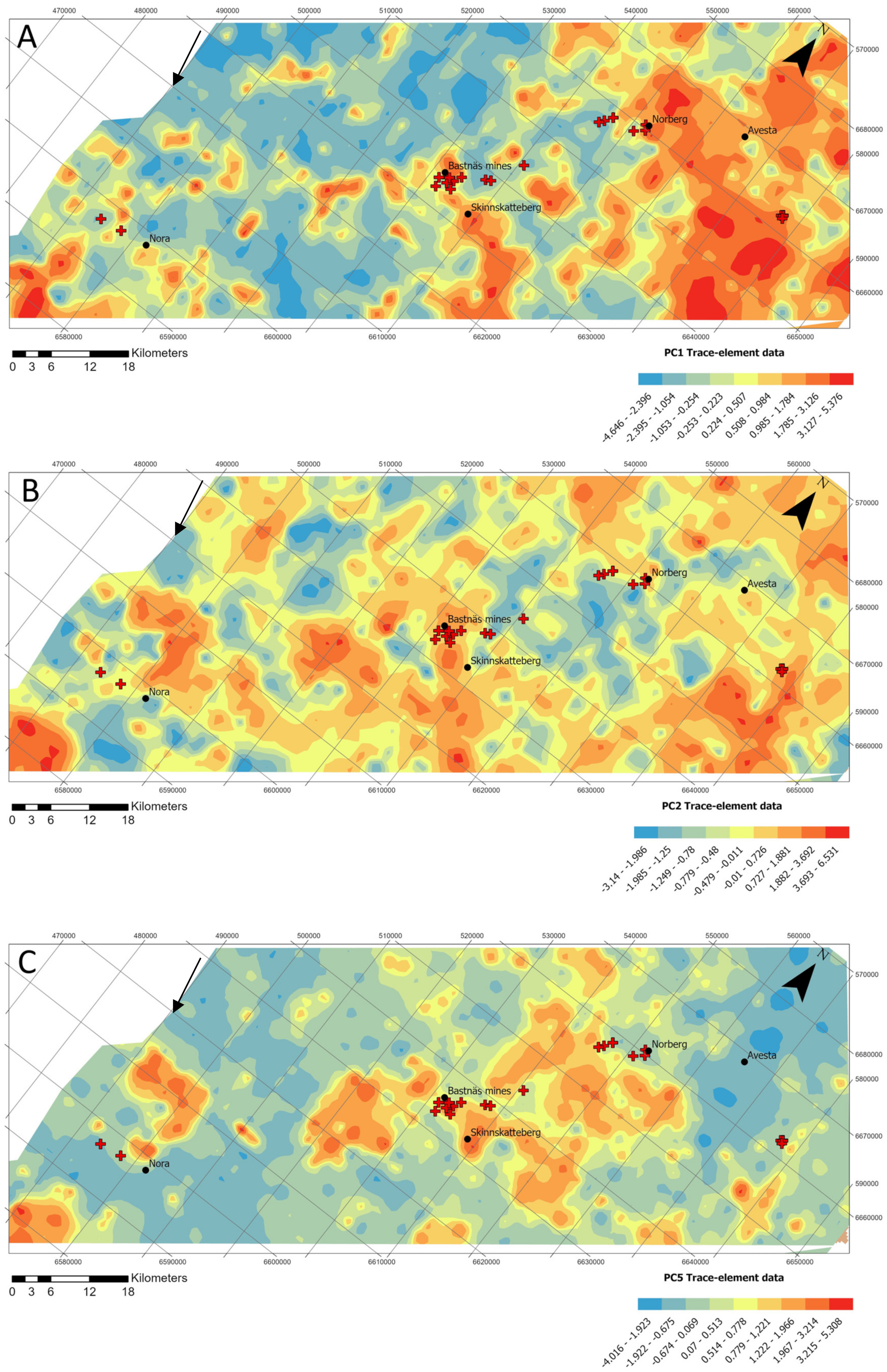

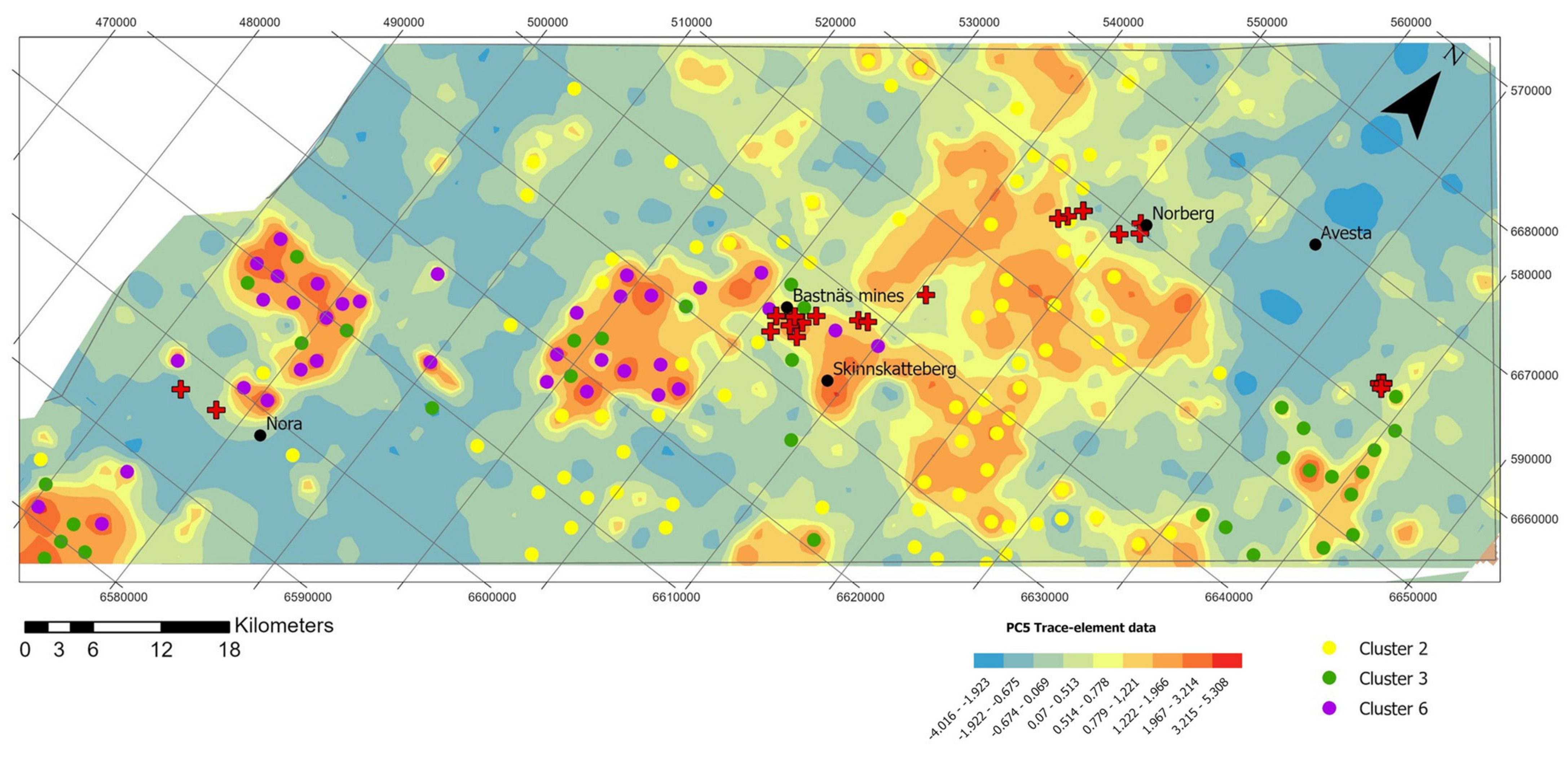

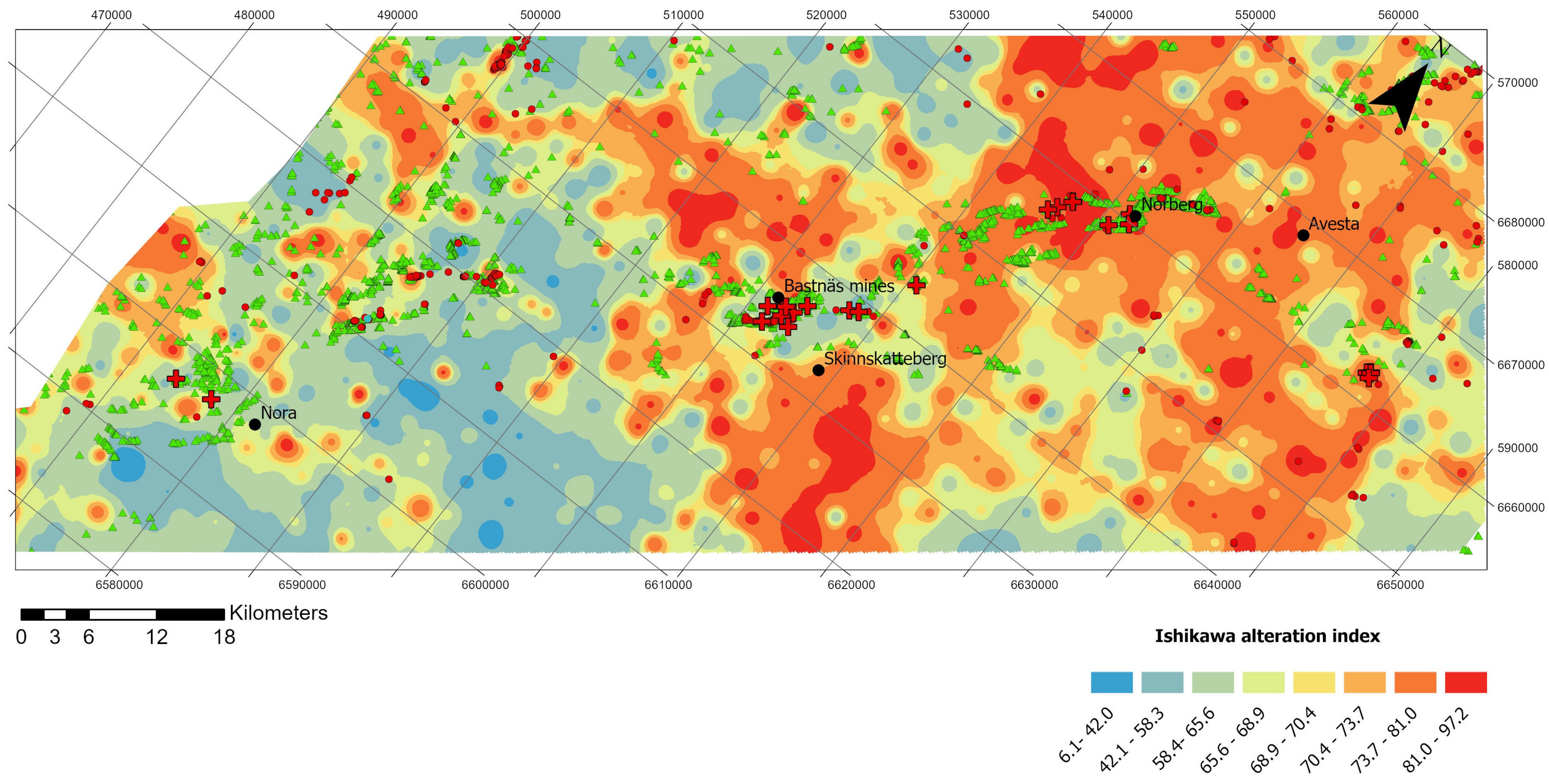
| Factor | Target Evidence | Mappable Geochemical Proxy | Sources of Uncertainty |
|---|---|---|---|
| Source | Ultramafic to mafic magmas | Principal component factor coupled with mafic chemistry | Unclear elemental associations due to mixing of signals in till |
| Trap | Reactive horizons or potential trap rocks | Principal component or cluster associated with carbonate rocks, positive HCl test of till | Weak reaction to acid, Ca from other Ca-rich minerals |
| Geochemical signatures of mineralization | Multivariate geochemical anomalies in till samples | Signatures obscured by other anomalous metal sources such as metal-rich granites | |
| Modification | Alteration (Mg-K-Ca-Na) of bedrock | Ishikawa alteration index; chlorite–carbonate–pyrite Index | Analytical uncertainty, poor leaching of elements from certain key minerals |
| Alkaline-type granites | Principal component factor coupled with felsic chemistry | Mixed geochemical signals |
| Element | Min | Max | Mean | Median | STD | Skew |
|---|---|---|---|---|---|---|
| Al | 2509 | 38,592 | 9772 | 9160 | 4825 | 1.3 |
| Ag | 0.01 | 0.2 | 0.1 | 0.057 | 0.0 | 1.8 |
| As | 0.2 | 81 | 2 | 1 | 5.1 | 10.0 |
| Ba | 4.0 | 162 | 26 | 21 | 18 | 2.2 |
| Be | 0.1 | 2.7 | 0.6 | 0.5 | 0.3 | 2.1 |
| Bi | 0.1 | 14 | 0.2 | 0.15 | 0.6 | 19 |
| Ca | 351 | 91,785 | 1885 | 1650 | 3297 | 23.1 |
| Cd | 0.0 | 0.9 | 0.1 | 0.05 | 0.0 | 9.9 |
| Co | 0.4 | 19.4 | 3.2 | 2.8 | 2.1 | 2.5 |
| Cr | 1.0 | 321 | 9.9 | 8.4 | 12.4 | 17.9 |
| Cu | 0.1 | 125 | 6.4 | 4.5 | 7.8 | 8.4 |
| Fe | 1213 | 48,828 | 9685 | 8615 | 5462 | 1.7 |
| K | 25 | 10,153 | 641 | 479 | 611 | 5.8 |
| La | 4.3 | 131 | 19.5 | 16.8 | 11.2 | 4.0 |
| Li | 0.9 | 55.1 | 6.4 | 5.2 | 4.8 | 2.8 |
| Mg | 199.0 | 23,027 | 2685.1 | 2288 | 1987 | 3.4 |
| Mn | 14.0 | 1220 | 144 | 116 | 116 | 3.3 |
| Mo | 0.1 | 20 | 0.4 | 0.2 | 1.0 | 14.0 |
| Na | 24.0 | 311.0 | 75.5 | 70 | 27.0 | 2.2 |
| Ni | 0.0 | 119.0 | 5.0 | 4.2 | 5.9 | 10.9 |
| P | 25.0 | 2091.0 | 394.3 | 368 | 211 | 2.1 |
| Pb | 2.3 | 130.5 | 8.9 | 7.4 | 8.1 | 7.5 |
| Rb | 1.3 | 174.2 | 8.5 | 6.2 | 8.6 | 9.0 |
| Se | 0.1 | 1.2 | 0.3 | 0.25 | 0.1 | 1.9 |
| Sn | 0.1 | 1.7 | 0.4 | 0.38 | 0.2 | 3.0 |
| Sr | 2.3 | 63.9 | 8.0 | 7.2 | 4.0 | 4.3 |
| Th | 2.9 | 129 | 11.1 | 9.5 | 8.5 | 5.3 |
| Ti | 160 | 2249 | 642.0 | 609 | 244 | 1.4 |
| Tl | 0.0 | 2.7 | 0.1 | 0.06 | 0.1 | 12.9 |
| U | 0.5 | 33.0 | 2.6 | 2.1 | 2.3 | 5.5 |
| V | 4.2 | 51.8 | 15.4 | 14 | 7.4 | 1.4 |
| W | 0.0 | 7.2 | 0.3 | 0.21 | 0.3 | 14.7 |
| Y | 3.0 | 62.0 | 12.0 | 11 | 5.9 | 3.0 |
| Zn | 2.5 | 15 | 20.2 | 16.1 | 16.2 | 2.8 |
| PC | Eigenvalue | Variance | Cumulative Variance (%) |
|---|---|---|---|
| PC1 | 6.6 | 19.5 | 19.5 |
| PC2 | 3.9 | 11.4 | 30.9 |
| PC3 | 3.3 | 9.7 | 40.5 |
| PC4 | 3.1 | 9.1 | 49.6 |
| PC5 | 2.1 | 6.2 | 55.8 |
| PC6 | 1.8 | 5.2 | 61.0 |
| PC7 | 1.5 | 4.5 | 65.5 |
| PC8 | 1.3 | 3.9 | 69.5 |
| PC9 | 1.2 | 3.4 | 72.9 |
| Element | PC1 | PC2 | PC3 | PC4 | PC5 | PC6 | PC7 |
|---|---|---|---|---|---|---|---|
| Al | −0.23 | −0.09 | 0.17 | −0.12 | 0.21 | 0.09 | 0.28 |
| Ag | 0.30 | 0.08 | 0.10 | 0.15 | 0.11 | 0.10 | 0.06 |
| As | −0.02 | 0.15 | −0.19 | −0.06 | 0.37 | 0.26 | 0.16 |
| Ba | −0.09 | 0.09 | 0.36 | −0.05 | 0.20 | 0.19 | 0.17 |
| Be | 0.00 | −0.10 | −0.33 | 0.02 | −0.11 | −0.36 | −0.14 |
| Bi | 0.10 | 0.14 | −0.08 | 0.18 | 0.18 | −0.24 | −0.10 |
| Ca | 0.21 | −0.16 | −0.09 | −0.04 | −0.02 | −0.02 | 0.20 |
| Cd | −0.17 | −0.17 | −0.05 | 0.02 | 0.01 | 0.02 | 0.14 |
| Co | 0.10 | 0.27 | −0.04 | 0.09 | 0.27 | 0.12 | −0.08 |
| Cr | −0.15 | 0.10 | 0.22 | −0.25 | 0.01 | 0.00 | 0.06 |
| Cu | −0.12 | −0.28 | −0.13 | 0.17 | 0.16 | 0.31 | 0.10 |
| Fe | 0.12 | 0.18 | 0.09 | 0.34 | −0.01 | −0.22 | 0.20 |
| K | 0.05 | −0.07 | −0.07 | 0.44 | 0.01 | 0.16 | 0.19 |
| La | 0.00 | −0.02 | −0.04 | −0.24 | 0.29 | −0.41 | −0.09 |
| Li | 0.25 | −0.12 | 0.12 | −0.10 | 0.13 | 0.16 | −0.22 |
| Mg | 0.04 | −0.19 | −0.22 | 0.01 | 0.42 | 0.03 | −0.19 |
| Mn | 0.00 | 0.19 | −0.05 | −0.30 | 0.03 | −0.03 | 0.16 |
| Mo | 0.00 | −0.36 | −0.08 | 0.10 | 0.04 | 0.19 | −0.12 |
| Na | 0.03 | −0.24 | −0.09 | 0.02 | −0.03 | −0.04 | 0.15 |
| Ni | 0.26 | −0.13 | 0.24 | −0.04 | −0.08 | 0.02 | −0.10 |
| P | −0.15 | −0.21 | 0.20 | 0.25 | −0.06 | −0.20 | 0.08 |
| Pb | 0.17 | 0.06 | −0.22 | 0.10 | 0.28 | −0.07 | 0.20 |
| Rb | −0.27 | −0.16 | −0.03 | −0.24 | 0.02 | −0.01 | 0.00 |
| Se | −0.24 | 0.17 | −0.03 | 0.06 | −0.13 | −0.12 | 0.21 |
| Sn | −0.15 | 0.27 | 0.08 | 0.00 | 0.23 | −0.08 | −0.05 |
| Sr | −0.02 | 0.20 | 0.04 | 0.16 | −0.05 | 0.02 | 0.28 |
| Th | 0.06 | −0.30 | 0.21 | 0.01 | 0.06 | −0.25 | 0.30 |
| Ti | 0.26 | 0.05 | −0.22 | −0.17 | −0.01 | 0.01 | 0.18 |
| Tl | 0.17 | −0.15 | 0.27 | −0.14 | 0.14 | 0.00 | −0.09 |
| U | −0.26 | −0.04 | −0.14 | 0.15 | 0.22 | −0.22 | −0.07 |
| V | −0.13 | 0.15 | −0.30 | −0.11 | −0.25 | 0.26 | −0.03 |
| W | −0.27 | 0.04 | 0.00 | 0.22 | −0.07 | 0.15 | −0.28 |
| Y | −0.14 | 0.10 | 0.27 | 0.23 | 0.14 | −0.02 | −0.34 |
| Zn | 0.30 | 0.13 | 0.04 | 0.05 | −0.16 | 0.03 | −0.10 |
| PC | Eigenvalue | Variance | Cumulative Variance (%) |
|---|---|---|---|
| PC1 | 5.4 | 21.7 | 21.7 |
| PC2 | 3.0 | 12.1 | 33.8 |
| PC3 | 2.6 | 10.3 | 44.1 |
| PC4 | 2.3 | 9.4 | 53.5 |
| PC5 | 1.7 | 6.7 | 60.2 |
| PC6 | 1.4 | 5.6 | 65.8 |
| PC7 | 1.3 | 5.0 | 70.8 |
| PC8 | 1.1 | 4.3 | 75.0 |
| PC9 | 1.0 | 4.1 | 79.1 |
| Element | PC1 | PC2 | PC3 | PC4 | PC5 | PC6 | PC7 |
|---|---|---|---|---|---|---|---|
| Ag | 0.29 | 0.20 | 0.16 | 0.21 | 0.11 | 0.00 | 0.13 |
| As | −0.17 | −0.01 | 0.31 | −0.33 | 0.11 | 0.30 | −0.02 |
| Ba | −0.12 | −0.09 | 0.02 | −0.19 | 0.52 | −0.23 | 0.20 |
| Be | −0.08 | 0.32 | 0.33 | −0.19 | 0.27 | −0.03 | −0.06 |
| Bi | −0.02 | −0.34 | −0.26 | 0.07 | −0.43 | 0.05 | −0.08 |
| Cd | 0.25 | −0.20 | 0.01 | −0.04 | 0.07 | −0.02 | −0.02 |
| Co | −0.18 | 0.22 | 0.07 | −0.23 | −0.20 | 0.42 | −0.07 |
| Cr | 0.01 | −0.06 | −0.02 | 0.22 | 0.12 | 0.26 | 0.42 |
| Cu | −0.16 | −0.35 | 0.18 | 0.21 | 0.17 | 0.28 | −0.13 |
| La | 0.27 | 0.14 | 0.13 | 0.34 | −0.06 | 0.09 | 0.10 |
| Li | −0.01 | −0.05 | 0.01 | −0.30 | −0.27 | −0.40 | 0.45 |
| Mo | −0.06 | 0.29 | −0.34 | −0.26 | −0.04 | 0.01 | 0.03 |
| Ni | 0.02 | −0.39 | 0.14 | −0.08 | 0.06 | 0.26 | 0.32 |
| Pb | 0.24 | −0.11 | −0.18 | −0.26 | 0.09 | 0.17 | 0.01 |
| Rb | −0.19 | 0.20 | −0.11 | −0.03 | −0.17 | 0.24 | 0.41 |
| Se | 0.33 | −0.04 | −0.06 | −0.16 | 0.09 | 0.21 | −0.04 |
| Sn | −0.26 | 0.10 | −0.10 | 0.04 | −0.11 | 0.15 | −0.20 |
| Sr | −0.04 | 0.21 | −0.06 | 0.17 | 0.07 | −0.06 | −0.25 |
| Th | −0.30 | −0.20 | 0.01 | 0.18 | −0.02 | −0.04 | 0.06 |
| Tl | 0.12 | −0.11 | 0.40 | −0.06 | −0.23 | −0.24 | −0.22 |
| U | −0.18 | 0.15 | −0.11 | 0.34 | 0.12 | −0.17 | 0.24 |
| V | 0.24 | −0.16 | −0.25 | −0.21 | 0.11 | −0.07 | −0.07 |
| W | −0.18 | −0.06 | −0.40 | −0.03 | 0.27 | 0.03 | −0.15 |
| Y | 0.26 | 0.08 | −0.24 | 0.15 | 0.19 | 0.13 | −0.07 |
| Zn | −0.33 | −0.20 | −0.02 | 0.01 | 0.15 | −0.19 | −0.10 |
Disclaimer/Publisher’s Note: The statements, opinions and data contained in all publications are solely those of the individual author(s) and contributor(s) and not of MDPI and/or the editor(s). MDPI and/or the editor(s) disclaim responsibility for any injury to people or property resulting from any ideas, methods, instructions or products referred to in the content. |
© 2024 by the authors. Licensee MDPI, Basel, Switzerland. This article is an open access article distributed under the terms and conditions of the Creative Commons Attribution (CC BY) license (https://creativecommons.org/licenses/by/4.0/).
Share and Cite
Casey, P.; Morris, G.; Sadeghi, M. Derivation of Predictive Layers Using Regional Till Geochemistry Data for Mineral Potential Mapping of the REE Line of Bergslagen, Central Sweden. Minerals 2024, 14, 753. https://doi.org/10.3390/min14080753
Casey P, Morris G, Sadeghi M. Derivation of Predictive Layers Using Regional Till Geochemistry Data for Mineral Potential Mapping of the REE Line of Bergslagen, Central Sweden. Minerals. 2024; 14(8):753. https://doi.org/10.3390/min14080753
Chicago/Turabian StyleCasey, Patrick, George Morris, and Martiya Sadeghi. 2024. "Derivation of Predictive Layers Using Regional Till Geochemistry Data for Mineral Potential Mapping of the REE Line of Bergslagen, Central Sweden" Minerals 14, no. 8: 753. https://doi.org/10.3390/min14080753
APA StyleCasey, P., Morris, G., & Sadeghi, M. (2024). Derivation of Predictive Layers Using Regional Till Geochemistry Data for Mineral Potential Mapping of the REE Line of Bergslagen, Central Sweden. Minerals, 14(8), 753. https://doi.org/10.3390/min14080753







